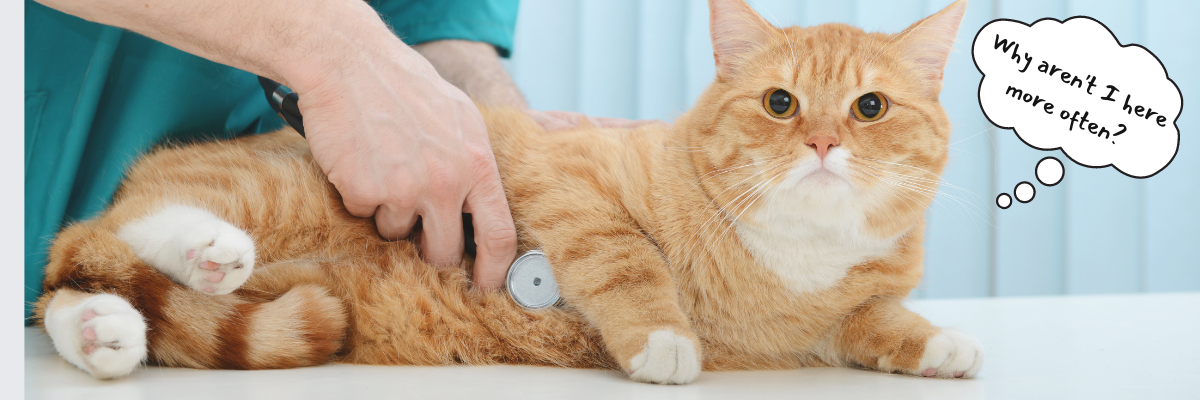 Web Content Viewer
Web Content Viewer
Increasing Feline Visits This Fall
Published on 8/30/21

With roughly 74 million cats in the United States, less than half of them are receiving veterinary care1. However, 56% of cat owners say they would bring their pet to the veterinarian more often if they knew it could prevent problems2. Cats represent an opportunity to us as the veterinary team.
Cats deserve proper veterinary care just like dogs, but many cat owners consider their pets self-sufficient and lack the understanding of how cats hide their illnesses. Cat owners also struggle with catching and transporting their pet to the veterinary clinic. Stress is a big factor in why we aren’t seeing cats as 58% of clients report bringing their cat to the vet is stressful for them as well3.
There are many variables at play when it comes to our feline patients: from getting them in the carrier, into the car, and their experience in your office. How can you encourage clients to consistently bring their cats in for preventative care?
Feline Friendly
It is important for all members of the veterinary team to understand the feline veterinary visit from the cat owner’s perspective, knowing the visit begins long before the cat enters your clinic. The struggle to catch the cat, forcing it into the carrier, listening to the cat yowl on the car ride, and the wait at the clinic is not a pleasant experience for many cat owners. When our feline patients arrive already stressed, it makes our job more challenging.
When we work together with the owner, steps can be taken ahead of time allowing transition from living room to exam room to be as stress free as possible.
The ideal cat carrier opens in the front as well as on top. It should be out in the home at all times with doors open. When the carrier is part of the cat’s everyday environment, transportation becomes much easier since the carrier isn’t seen as something foreign.
In addition to being comfortable in their carrier, we need to make sure the cat will tolerate the car ride. The temperature inside the car should be similar to indoor temperatures. If transporting a cat during colder months of the year recommend that owners cover the carrier with a heavy blanket when walking from house to car and car to clinic. Owners should occasionally place the cat in the carrier, go for a short ride around the block and back home. This helps the cat to realize he isn’t heading to the vet every time he is put in the carrier and into the car.
Consider allowing feline families to wait in their car until an exam room is ready which prevents stressors like barking dogs in the lobby. Use food rewards such as microwaved tiny shrimp or whipped cream to encourage cats.
Share a video of your feline patients enjoying their veterinary experience on social media to promote how you are feline friendly! Feline friendly tips should be discussed by the technicians and doctors during the visit.
Acknowledging the difficulty cat owners face when transporting their pet adds value to their visit and helps those owners feel compassion and empathy from your team. This is one step in making sure they bring their cat to you, year after year.
The Importance of Kitten Visits
Kitten visits are the key to increasing your feline visits. Each time you are given the chance to examine a kitten, look at this as an opportunity to educate the owner and encourage preventative care.
According to the AAFP, cats are typically unplanned acquisitions with more than 50% of cat owners stating they did not seek ownership and 69% did not pay anything for their cat.
Kittens should receive at least 2 visits. This prevents clients from being overwhelmed with the amount of education you provide them and also ensures the kitten is healthy and demonstrates the value of your preventative care. Talk through your physical exam to add value to their visit and be assertive and clear with your recommendations.
As not all people are auditory learners, it is helpful to provide handouts for owners to read that will educate them on routine vaccinations, parasite prevention, and annual bloodwork.
Schedule their next visit before they leave the building so owners know when their cat needs to return. Take pictures of owners with their new kitten and share on your social media platforms illustrating your cat friendly clinic. Don’t forget to follow up with every feline visit so you can answer any questions that may have come up and to ensure the cat adjusted well after leaving the clinic.
Working together as a team, you can develop feline friendly tactics that work best for your practice, increase your feline visits, and have fun in the process! It is very rewarding to perform a stress-free physical exam on a cat and to have that client come back year after year.
1. Volk, J.O, Thomas, J.G., Colleran, E.J. (2014). Bayer Veterinary Care Usage Study: Feline Findings. Journal of the American Veterinary Medical Association, Vol 244, No. 7, April 1, 2014, 799-802.
2. Bayer Veterinary Care Usage Study (2011).